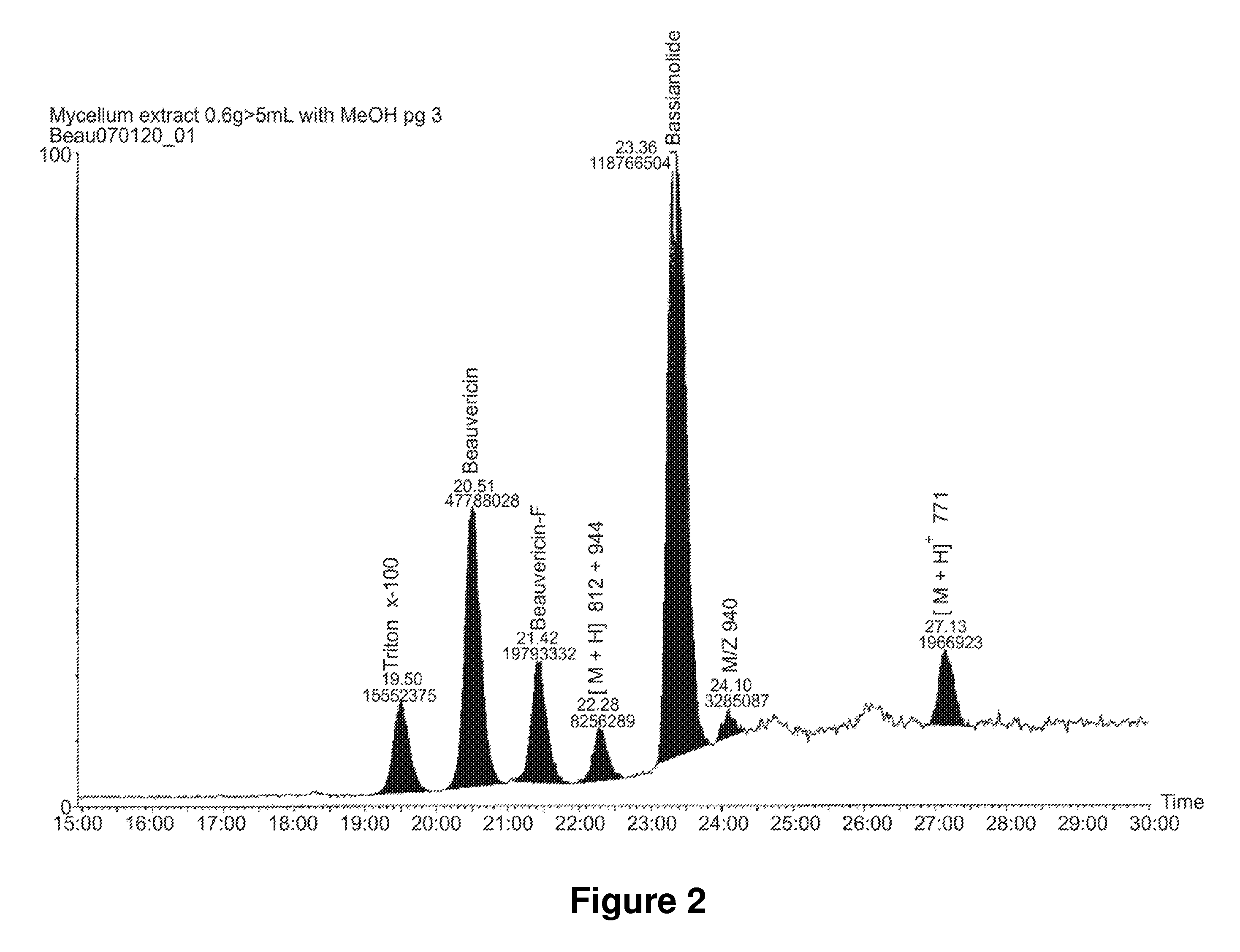Entomopathogenic Fungi and Uses Thereof
a technology which is applied in the field of entomopathogenic fungi and metabolites, can solve the problems of plant disease caused by pathogens such as insects, affecting plant health, and affecting plant health,
- Summary
- Abstract
- Description
- Claims
- Application Information
AI Technical Summary
Benefits of technology
Problems solved by technology
Method used
Image
Examples
example 1
Identification and Isolation of Beauveria bassiana Strain K4B3
[0207]Beauveria bassiana K4B3 was originally isolated from a group of dead cicada pupae that had come to the surface of the soil and died on mass in a pine forest at Bombay, New Zealand. Fungi was isolated from the insect sample using standard procedures, including growth at 24 C at 93% relative humidity to maximise sporulation. Individual colonies were then sub-cultured onto MEA to yield pure strains for screening for entomopathogenic efficacy.
Beauverium Characteristics
[0208]The isolate was identified as Beauverium bassiana using taxonomic references well known in the art.
Morphological Characteristics
[0209]The isolate K4B3 is pathogenic to thrip juveniles, adults, and pupae, aphids and whitefly. This isolate has the following identifying characteristics:
[0210]Mycelium: Grows readily on MEA. Colonies are generally white at the edge becoming cream to pale yellow. Very occasionally reddish. Underside of mycelium thallus inf...
example 2
Comparison of Whitefly Control Using K4B3 and Chemical Insecticides
Introduction
[0214]This example describes field trials that are conducted to assess the efficacy of Beauverium bassiana strain K4B3 as a biological control agent of whitefly, and comparing same to established chemical treatment procedures. The trial is conducted in two 1680 m2 Venlo style Faber glasshouses, complete with coal fired boilers and Chemtest environment and irrigation controllers. The glasshouses are in all cases, apart from drainage of runoff, identical. A chemical pesticide regime is conducted in Glasshouse 1, and a trial of the BCA of the present invention is conducted in Glasshouse 2.
Methods
[0215]Glasshouse 1
[0216]This glasshouse is planted with the De Ruiter variety Antarctica. As is normal practice after establishment, plants are allowed to reach knee high before Vydate (240 gm / L oxamyl) is applied via the irrigation at 100 ml / 1000 m2. As the crop progresses, the dose of Vydate is increased to 200 ml / ...
example 3
Production OF Beauveria bassiana
Introduction
[0223]This example describes a method for the large scale solid phase growth of Beauverium bassiana strain K4B3 and the production of a composition comprising one or more metabolites thereof.
Methods
Germination of Conidia
[0224]Optimal spore formation requires a saturated atmosphere and a temperature of 25 to 30° C. Following spore formation, spores were transferred into a dry sealable container and stored at 8° C. The spores may be so stored for up to 635 days.
[0225]Solid Phase, Large Scale Growth
[0226]After 300 days in storage, the hydrophobic spore powder was removed from storage and its viability was tested as follows.
[0227]Malt Extract Agar (fortified with 20,000 I.U. Penicillin / L and 40 mg Streptomycin / L) at pH 5.5 was prepared. A 1 mL aliquot of a spore suspension was added to the Malt Extract Agar, smeared and incubated for 14 days at 24° C.
[0228]At 15 days, the fungi was harvested into sterile water supplemented with 0.01% Triton×1...
PUM
 Login to View More
Login to View More Abstract
Description
Claims
Application Information
 Login to View More
Login to View More - R&D
- Intellectual Property
- Life Sciences
- Materials
- Tech Scout
- Unparalleled Data Quality
- Higher Quality Content
- 60% Fewer Hallucinations
Browse by: Latest US Patents, China's latest patents, Technical Efficacy Thesaurus, Application Domain, Technology Topic, Popular Technical Reports.
© 2025 PatSnap. All rights reserved.Legal|Privacy policy|Modern Slavery Act Transparency Statement|Sitemap|About US| Contact US: help@patsnap.com


